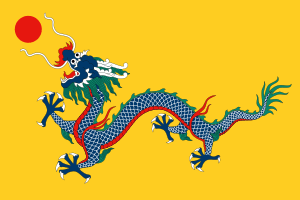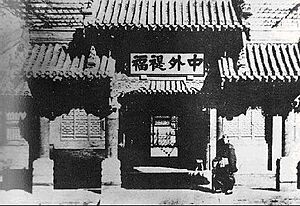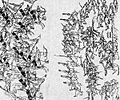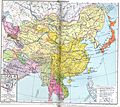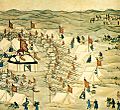Qing dynasty facts for kids
The Qing dynasty (Chinese: 清朝; pinyin: Qīng cháo) was a group of rulers who led China from 1644 to 1912. This dynasty was started by the Manchu people, so it's also known as the Manchu dynasty. The emperors of the Qing dynasty had the family name Aisin Gioro.
Contents
Rise of the Manchu State
In 1580, a leader named Nurhaci became a general for the Ming dynasty. He brought the different Manchu tribes together and created a special army system called the Eight Banners. In 1616, Nurhaci declared himself Khan (which means King) and started the Jin dynasty in a place called Liao Ling.
In 1626, Nurhaci attacked Ning Yuan with his armies. Sadly, he was hurt by a cannon shot from Yuan Chonghuan's forces and died two days later. His son, Huang Taiji, then became the new Khan of the Manchu people. Huang Taiji passed away in 1643 due to a stroke.
Shunzhi Emperor took over the throne from Huang Taiji. Prince Dorgon became the leader who ruled for the young emperor. In 1644, the Manchu armies successfully took control of northern China. They moved their capital city to Beijing. This event led to the end of the Ming dynasty.
Late Qing Period
Efforts to Improve China
The Self-Strengthening Movement (1861 - 1895)
The Self-Strengthening Movement (Chinese: 洋務運動 or 自強運動) was a big effort to make China stronger. It happened from 1861 to 1895. After losing the Opium Wars and facing the huge Taiping Rebellion, the emperor and his officials realized China needed to change. They started this movement to improve the country.
This movement had three main parts: the first from 1861 to 1872, the second from 1872 to 1885, and the third from 1885 to 1895. Important leaders included Yixin, Prince Gong, Wenxiang, Zeng Guofan, Li Hongzhang, Zuo Zongtang, Shen Baozhen, and Zhang Zhidong. However, the movement faced challenges from people who didn't want change and problems with bringing in new ideas. In the end, it did not fully succeed.
What They Tried to Change
- Making the Country Stronger
- Helping Business and Trade
- New, modern banks were opened.
- Many new factories and businesses were started in southern China.
- Modernizing Foreign Relations
- The Zongli Yamen, a special office for dealing with other countries, was set up in 1861.
- In 1868, the Qing government sent its first official group of representatives to other countries.
The Hundred Days' Reform (1898)
After the Self-Strengthening Movement didn't work as hoped, and after China lost the First Sino-Japanese War, many leaders knew that more changes were urgently needed. This led to the Hundred Days' Reform (Chinese: 戊戌變法), which lasted from June 11 to September 21, 1898.
The main leaders of this reform were the Guangxu Emperor, Kang Youwei, and Liang Qichao. However, the reform ended quickly when Empress Dowager Cixi led a sudden takeover of power.
What They Tried to Change
- Government Changes
- They planned to get rid of government jobs that were not useful.
- Military Changes
Qing Government and Society
How Politics Worked
The Manchus started to adopt many ways of the Chinese people. This helped them rule China better. Manchus began to wear Chinese clothes and write in Chinese. They also started to enjoy Chinese food and art.
One Manchu emperor, the Qianlong Emperor, worried that the Manchus were becoming too much like the Chinese. He tried to encourage Manchus to remember their own traditions. He made them practice horse riding and shooting bows and arrows. This was to help them remember where they came from.
Regional Development
- Guangdong
In the early Qing period, Guangdong was a large province. It had 79 different areas called counties. By 1911, records showed there were about 5,041,780 families, which meant around 28,001,564 people lived there. Famous mountains in Guangdong included Lingchau, Huangling, and Luofu. The most important rivers were Dongjiang, Beijiang, and Xijiang. Major cities in Guangdong were Guangzhou, Zhaoqing, Xiamen, and Fujian.
Images for kids
-
Sura han ni chiha (Coins of Tiancong Khan) in Manchu alphabet
-
Dorgon (1612–1650)
-
The Kangxi Emperor (r. 1662–1722)
-
Putuo Zongcheng Temple, Chengde, Qianlong reign; built on the model of Potala Palace, Lhasa
-
Campaign against the Dzungars in the Qing conquest of Xinjiang 1755–1758
-
Lord Macartney saluting the Qianlong Emperor
-
Silver coin: 1 yuan/dollar Xuantong 3rd year - 1911 Chopmark
-
A Daoguang period Peking glass vase. Colored in "Imperial Yellow", due to its association with the Qing.
-
Jade book of the Qianlong period on display at the British Museum
See also
 In Spanish: Dinastía Qing para niños
In Spanish: Dinastía Qing para niños


